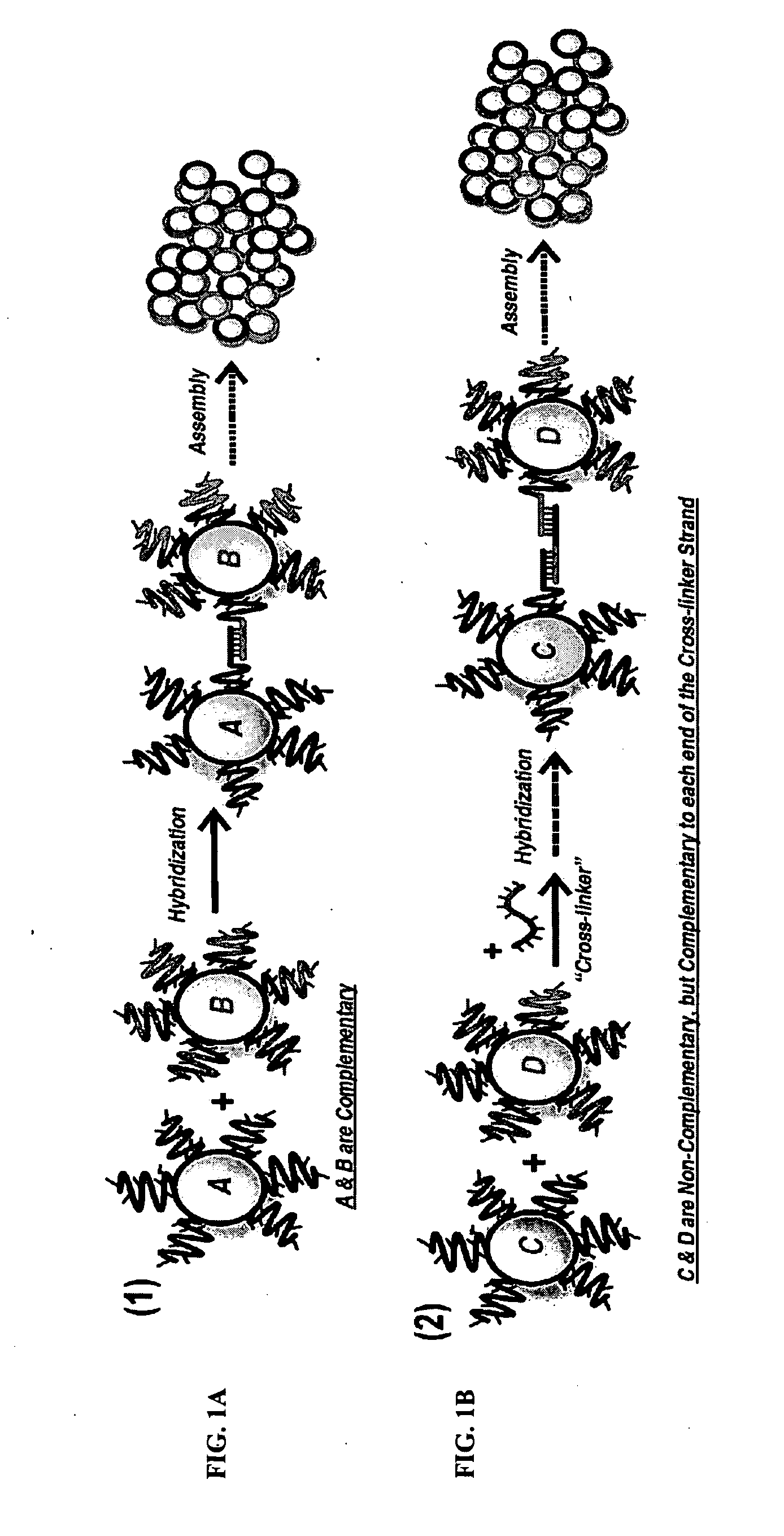DNA-Guided Nanoparticle Assemblies
a dna-guided, particle technology, applied in the direction of organic compounds/hydrides/coordination complexes, organic chemistry, physical/chemical process catalysts, etc., can solve the problems of harsh organic solvent environment (toluene, hexane), lack of tunable post-assembly structure, and lack of addressable chemistries at the nanoparticle surface, etc., to achieve a small synthetic workload
- Summary
- Abstract
- Description
- Claims
- Application Information
AI Technical Summary
Benefits of technology
Problems solved by technology
Method used
Image
Examples
example 1
Tunability of Assembly Kinetics
[0067]Nanoparticle Synthesis Gold nanoparticles (Au, 9.6±0.6 nm) were synthesized by a slightly modified citrate (Cit) reduction procedure. Briefly, an aged 1 mM HAuCl4 solution was heated to ˜95° C. for 30 minutes. To this solution a warm 38 mM trisodium citrate solution (10 ml) was added in one aliquot. Upon initial color change to red, the solution was then immediately cooled to ˜80° C. and annealed for 2 hours. The sample was then allowed to cool naturally to room temperature with overnight stirring. The solution was then purified via centrifugation (30 min, 7,000 RPM) and stored at desired concentrations protected from light. In an exemplary experiment, the size of the Au particles increased with longer boiling times. The Au concentrations were calculated via measured extinction coefficients of 1.0×108 L mole−1 cm−1.
[0068]DNA-Nanoparticle Modification: Thiol-functionalized single stranded oligo-nucleotides of type 1 (1=5′-TAC TTC CAA TCC AAT-(T)15...
example 2
Enhancement of Assembly Kinetics
[0095]The assembly kinetics was even more dramatically enhanced when the nanoparticle was functionalized with more than one type of ssDNA. FIG. 3 shows an idealized representation for a system which possesses both a complementary type 1 (A, A′, *A, and *A′) ssDNA, with the addition of a neutral, non-hybridizing strand of type 3 (C and *C) (3=5′-TTC TCT ACA CTG TCT-(T)15-C3H6-SH -3′). The ratio between type 1 (or type 2) and type 3 can be controlled via functionalization methods.
[0096]FIG. 5A shows a set of kinetic plots for a system which consists of ˜75% of non-complementary neutral type 3 (C) ssDNA and 25% complementary strands (A, A′), type 1 and type 2. Due to the presence of type 3 ssDNA, the assembly was extremely slow (circles). However, upon the selective hybridization of the spacer sequences of the aggregation-promoting complementary type 1 (*A) and type 2 (A′) ssDNAs, the assembly kinetics were dramatically increased (triangles). FIG. 5B sho...
example 3
Crystalline Gold Nanoparticle Assemblages
[0099]Nanoparticle Synthesis & DNA-functionalization: Gold nanoparticles (Au, 11.4±1.0 nm) were synthesized by first heating a mM HAuCl4 solution to ˜95° C. for 30 minutes. To this solution, a warm (˜40° C.) 10-ml aliquot of 38-mM trisodium citrate solution was added and let to react for a few minutes. Upon initial color change to red, the solution was immediately cooled to about 80° C. and annealed for 2 hours. The sample was left to cool to room temperature and allowed to stand overnight. The solution was then purified via centrifugation (30 min, 4,500 g) and stored at the desired concentrations in the dark.
[0100]Thiol- or amine-modified single-stranded oligonucleotides were purchased (Integrated DNA Technologies Inc., Coralville, Iowa, U.S.A; Primesyn Lab Inc., Hillsborough, N.J., U.S.A) as disulfides, Table 1. Before nanoparticle functionalization, the oligonucleotides were first reduced by dissolving the lyophilized samples (100-300 nmol...
PUM
| Property | Measurement | Unit |
|---|---|---|
| Length | aaaaa | aaaaa |
| Fraction | aaaaa | aaaaa |
| Fraction | aaaaa | aaaaa |
Abstract
Description
Claims
Application Information
 Login to View More
Login to View More - R&D
- Intellectual Property
- Life Sciences
- Materials
- Tech Scout
- Unparalleled Data Quality
- Higher Quality Content
- 60% Fewer Hallucinations
Browse by: Latest US Patents, China's latest patents, Technical Efficacy Thesaurus, Application Domain, Technology Topic, Popular Technical Reports.
© 2025 PatSnap. All rights reserved.Legal|Privacy policy|Modern Slavery Act Transparency Statement|Sitemap|About US| Contact US: help@patsnap.com



